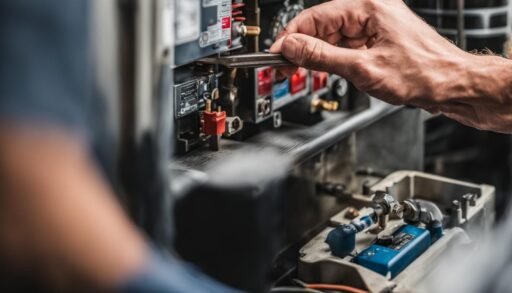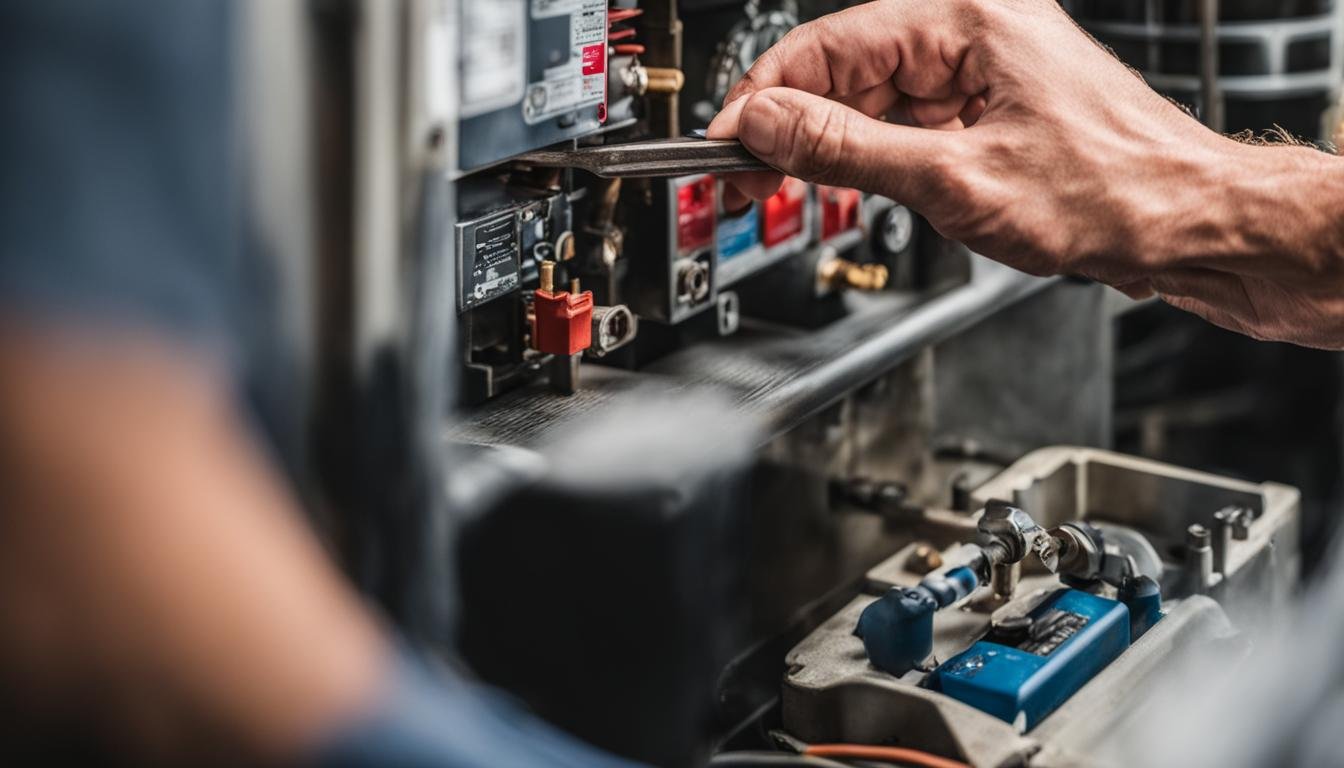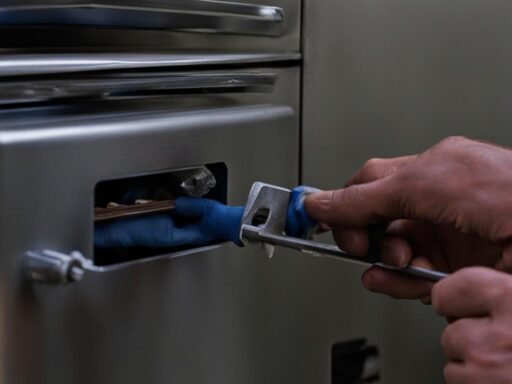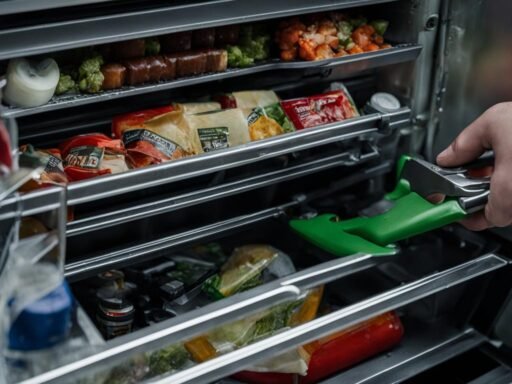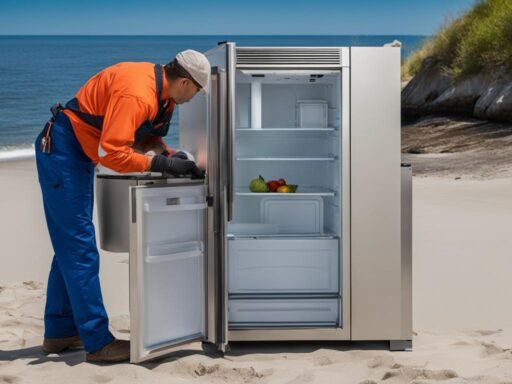Dryer repair can be a simple and cost-effective solution to common issues that can arise with your Sub Zero dryer. In many cases, you can tackle the repair yourself, avoiding the hassle and expense of hiring a professional technician. With a few basic tools and some troubleshooting know-how, you can get your dryer back up and running in no time.
Before diving into the repair process, it’s crucial to prioritize safety. Always remember to unplug your dryer before attempting any repairs. This precaution will protect you from the risk of electric shocks and other potential hazards.
In this guide, we will walk you through the step-by-step process of disassembling your dryer, diagnosing common issues, and providing easy and effective solutions for repair. By following these instructions, you can save both time and money while ensuring the optimal performance of your Sub Zero dryer.
Key Takeaways:
- With basic tools and troubleshooting knowledge, you can tackle Sub Zero dryer repairs yourself.
- Always remember to unplug your dryer before attempting any repairs for safety purposes.
- Follow the step-by-step instructions in this guide for disassembling your dryer and diagnosing common issues.
- Learn easy and effective solutions for repairing your Sub Zero dryer, saving both time and money.
- Regular maintenance and cleaning can help prevent common issues with your dryer.
Unplug Your Dryer Before Repairing It
When it comes to dryer repair, safety should always be your top priority. Before you delve into any repairs or maintenance tasks, it is crucial to unplug your appliance from the power source. This simple yet essential step ensures that you can work on your dryer without the risk of electric shocks or other accidents.
Unplugging your dryer not only protects you from potential harm, but it also safeguards your appliance from further damage caused by accidental power surges during repair. By disconnecting it from the power supply, you create a safe working environment for yourself and minimize the risk of electrical mishaps.
Once your dryer is safely unplugged, you can begin the repair process. However, before you start taking apart the machine, it’s important to check for electricity to ensure that your repair efforts will be effective. Often, a dryer may appear to be malfunctioning when, in reality, the issue lies with an unplugged cord or a tripped circuit breaker.
Please note: If you’re unsure about how to check for electricity or diagnose the problem with your dryer, it’s advisable to consult a professional technician. They have the expertise and tools required to perform accurate troubleshooting and repair any issues with your Sub Zero dryer.
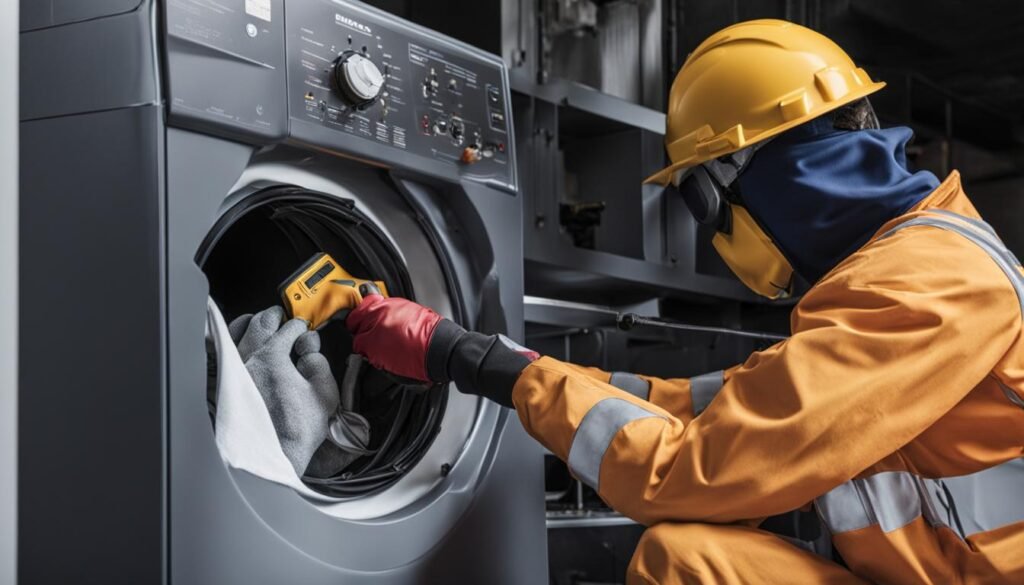
By following these safety precautions and unplugging your dryer before repair, you can protect yourself and your appliance from potential harm. Now that you’re aware of the importance of this step, let’s move on to the next section to learn how to disassemble a dryer to access its parts for repair.
How to Disassemble a Dryer
Most dryer repairs require some level of disassembly to access the parts. The process of disassembling a dryer varies depending on the location of the lint filter. Proper disassembly is essential for accessing the necessary parts for repairs.
-
Start by unplugging the dryer and moving it to a well-lit area with enough space for disassembly.
-
Remove the lint filter and clean any lint or debris that has accumulated. This step ensures optimal dryer performance and prevents potential fire hazards.
-
Remove the screws or clips that secure the dryer’s top panel. This will vary depending on the model of your dryer. Refer to the manufacturer’s manual or online resources for specific instructions for your dryer model.
-
Once the top panel is removed, locate and remove the screws or clips that secure the front panel to the cabinet.
-
Gently tilt the front panel forward and disconnect any wires or connectors that attach it to the rest of the dryer. Take note of the location and arrangement of these wires for reassembly.
-
If necessary, remove the drum by disconnecting the belt from the idler pulley and motor pulley. Carefully lift the drum out of the dryer cabinet.
-
With the drum removed, you will have better access to the dryer’s internal components. Identify the faulty part or parts that need to be repaired or replaced.
Remember to exercise caution and follow safety guidelines throughout the disassembly process. If you’re unsure about any step, consult a professional Sub Zero dryer technician for assistance.
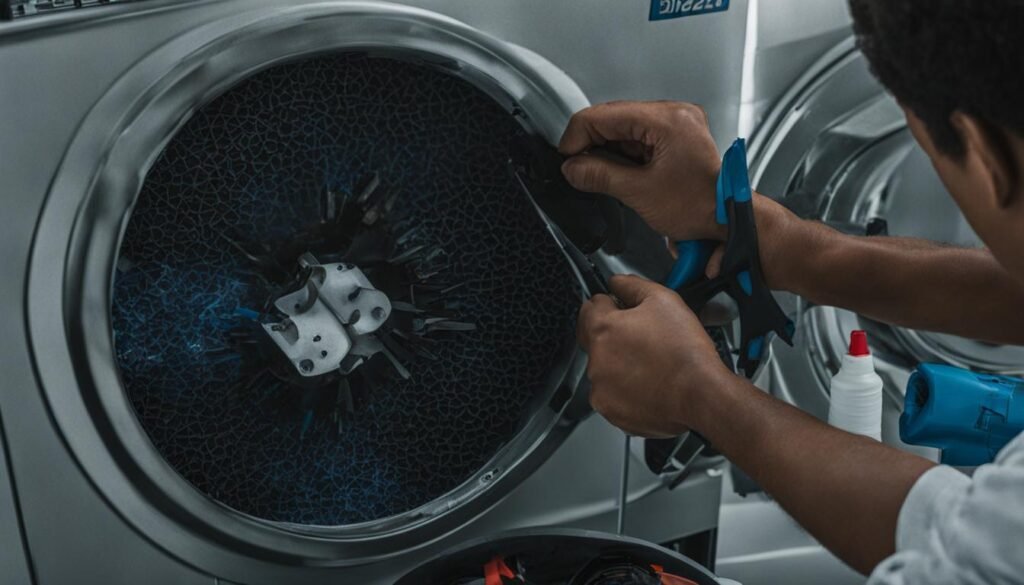
Proper disassembly of your dryer allows you to access the necessary parts for repairs or replacements. However, if you’re not confident in your ability to disassemble and repair your dryer on your own, it’s always best to seek the help of a certified Sub Zero dryer technician. They have the expertise and experience to diagnose and fix any issues with your dryer quickly and efficiently.
How to Fix a Dryer That Won’t Start
If your dryer does not start when you turn it on, it can be frustrating. However, there are a few common issues that you can troubleshoot on your own before calling for professional help. The most likely causes of a non-starting dryer are a faulty door switch or plunger, which can wear out over time.
Testing the door switch: Start by disconnecting the dryer from the power source to ensure safety. Locate the door switch, usually found near the door latch or strike plate. Use a multimeter or continuity tester to test the switch for continuity. If there is no continuity when the switch is pressed, it is likely faulty and needs to be replaced.
Checking the thermal fuse: The thermal fuse is a safety device that shuts off the dryer’s heating element if it overheats. If the fuse is blown, the dryer will not start. To check the thermal fuse, disconnect the dryer from the power source and remove the back panel. Locate the thermal fuse, usually near the heating element, and use a multimeter to test it for continuity. If there is no continuity, the thermal fuse is likely faulty and needs to be replaced.
If both the door switch and thermal fuse are functioning properly, there may be a different issue causing the dryer not to start. In such cases, it is recommended to seek assistance from a professional technician who specializes in sub zero dryer repair.
Remember to always prioritize safety when working with electrical appliances. If you are unsure or uncomfortable with any steps in the troubleshooting process, it’s best to consult a professional to avoid any potential hazards.
| Problem | Possible Cause | Solution |
|---|---|---|
| Dryer doesn’t start | Faulty door switch or plunger | Test the door switch for continuity and replace if faulty. Check the thermal fuse and replace if blown. |
What to Do if Your Dryer Is Making Noises
If you notice thumping or rumbling sounds coming from your Sub Zero dryer, it is important to address the issue promptly to prevent further damage. These noises are often caused by worn-out drum support rollers, which can create a disruptive and annoying experience.
To fix the noise issue, you will need to replace the worn-out drum support rollers. It is also recommended to replace the tensioner roller if necessary. By replacing both rollers and belts at the same time, you can ensure a smoother and quieter operation of your dryer.
Here are the steps to follow for replacing the drum support rollers:
- Disconnect the power: Before starting any repairs on your dryer, make sure to unplug it from the power source to ensure your safety.
- Access the drum: Use a screwdriver or socket set to remove the dryer’s front panel or top panel, depending on your specific model. This will allow you to access the drum and the damaged rollers.
- Remove the old rollers: Locate the drum support rollers near the rear of the drum. Detach them from the drum and remove them carefully.
- Install the new rollers: Take the new drum support rollers and position them on the drum. Make sure they fit securely before moving on to the next step.
- Reassemble the dryer: Put the front panel or top panel back in place and secure it using the screws or fasteners.
- Test the dryer: Plug the dryer back in and test it to ensure that the noise issue has been resolved. If the dryer is still making unusual noises, you may need to further inspect and troubleshoot the problem.
By following these steps, you can effectively address the noise issue in your Sub Zero dryer and restore its smooth and quiet operation. However, if you’re not confident in your DIY skills or the issue persists, it is recommended to seek professional assistance from a certified Sub Zero dryer repair technician. They have the expertise and knowledge to diagnose and resolve any complicated issues with your dryer.
Tips for Preventing Dryer Noises
Regular maintenance and care can help prevent common issues, including noisy dryers. Here are a few tips to keep your Sub Zero dryer in optimal condition:
- Clean the lint filter: Regularly clean the lint filter to prevent lint buildup, which can lead to airflow restrictions and strain on the dryer components.
- Inspect the drum: Occasionally check the drum for any foreign objects, such as coins or buttons, that may cause noise or damage.
- Avoid overloading: Overloading the dryer can put excessive strain on the drum and rollers, leading to increased wear and noise. Follow the manufacturer’s guidelines for load capacity.
- Keep the dryer level: Ensure that your dryer is properly leveled to prevent it from vibrating excessively during operation.
- Check for loose parts: Periodically inspect the dryer for loose screws or bolts. Tighten them if necessary to prevent rattling noises.
By implementing these preventive measures and promptly addressing any dryer noise issues, you can extend the lifespan of your Sub Zero dryer and enjoy a quiet and efficient drying experience.
Dryer Isn’t Heating
If your Sub Zero dryer is not drying clothes properly, it can be a frustrating experience. However, there are several troubleshooting steps you can take to identify and fix the issue.
Step 1: Check the Airflow
The first step is to check the airflow from the dryer vent tube. A clogged or restricted vent can prevent proper drying by limiting the airflow. This can be caused by a buildup of lint or other debris. Ensure that the vent tube is clear and free from obstructions.
Step 2: Check the Breaker Box
If the airflow is not the issue, the next step is to check the breaker box. A tripped breaker can disrupt the heating element in the dryer and cause it to stop working. Make sure the breaker that controls the dryer is in the correct position. If it has tripped, reset it and see if that resolves the problem.
Step 3: Clean the Lint Filter
A dirty or clogged lint filter can also prevent the dryer from heating properly. Remove the lint filter and clean it thoroughly. Make sure there is no lint buildup that could hinder the airflow. Cleaning the lint filter regularly is an important maintenance task to ensure efficient drying.
Step 4: Test the Thermal Fuse, Radiant Sensor, and Gas Valve Coils
If the previous steps haven’t solved the issue, it’s time to test the internal components of the dryer. The thermal fuse, radiant sensor, and gas valve coils can all cause heating problems if they are faulty. Use a multimeter to test these components for continuity and replace them if necessary.
Remember, if you are uncomfortable or unsure about performing these troubleshooting steps, it’s always best to seek professional assistance. Sub Zero dryer repair technicians are trained to handle these types of repairs safely and effectively.
| Issue | Possible Causes | Solutions |
|---|---|---|
| Dryer not drying clothes | Clogged vent tube Tripped breaker Dirty lint filter |
Clear vent tube Reset breaker Clean lint filter |
| No heat | Faulty thermal fuse Malfunctioning radiant sensor Defective gas valve coils |
Test and replace faulty components |
Conclusion
Dryer repairs can often be done by yourself, saving you both time and money. However, it’s important to note that some repairs may require the expertise of a professional technician. Safety should always be a priority, and proper diagnosis is crucial before attempting any repairs.
Regular maintenance and cleaning of your dryer can go a long way in preventing common issues. Simple tasks like cleaning the lint filter and ensuring proper airflow can help keep your dryer running smoothly. By taking these preventive measures, you can avoid unnecessary breakdowns and extend the lifespan of your appliance.
When it comes to complex repairs or if you’re unsure about tackling a problem on your own, it’s best to hire a certified service technician. They have the knowledge and experience to diagnose and fix issues efficiently and effectively. They can also ensure the use of genuine Sub Zero parts, giving you peace of mind.
In conclusion, while DIY dryer repairs can be an option in some cases, it’s important to prioritize safety and proper diagnostics. Regular maintenance and the assistance of a professional technician when needed are key to keeping your Sub Zero dryer in optimal condition.
FAQ
Can I repair my Sub Zero dryer myself?
Yes, many dryer repairs can be done by yourself, saving you time and money. Basic tools like a socket set and screwdrivers, along with a continuity tester or multimeter, may be needed for diagnosis.
Why is it important to unplug the dryer before repairing it?
Unplugging the appliance ensures safety before attempting any repairs. Checking for electricity is the first step in dryer repair, as unplugged cords and tripped breakers are common causes of dryer “breakdowns.”
How do I disassemble a Sub Zero dryer?
The process of disassembling a dryer varies depending on the location of the lint filter. Proper disassembly is essential for accessing the necessary parts for repairs. Professional assistance from a certified Sub Zero technician may be required.
What should I do if my dryer doesn’t start?
If your dryer does not start when you turn it on, a faulty door switch or plunger may be the cause. Testing the switch for continuity and checking the thermal fuse are important steps in dryer troubleshooting.
How can I fix thumping or rumbling sounds coming from my dryer?
Thumping or rumbling sounds often indicate worn-out drum support rollers. Replacing these rollers, along with the tensioner roller if necessary, can fix the noise issue. It is recommended to replace both rollers and belts at the same time.
What should I do if my dryer isn’t drying clothes?
If your dryer is not drying clothes, the first step is to check the airflow from the dryer vent tube. A clogged vent can prevent proper drying. If the airflow is not the issue, other common fixes include checking the breaker box and cleaning the lint filter. Testing the thermal fuse, radiant sensor, and gas valve coils are additional steps for troubleshooting.
When should I hire a professional for Sub Zero dryer repairs?
While many dryer repairs can be done DIY, some may require technical expertise and the assistance of a professional. Regular maintenance and cleaning can help prevent common issues. Hiring a certified service technician can provide peace of mind and ensure the use of genuine Sub Zero parts.
